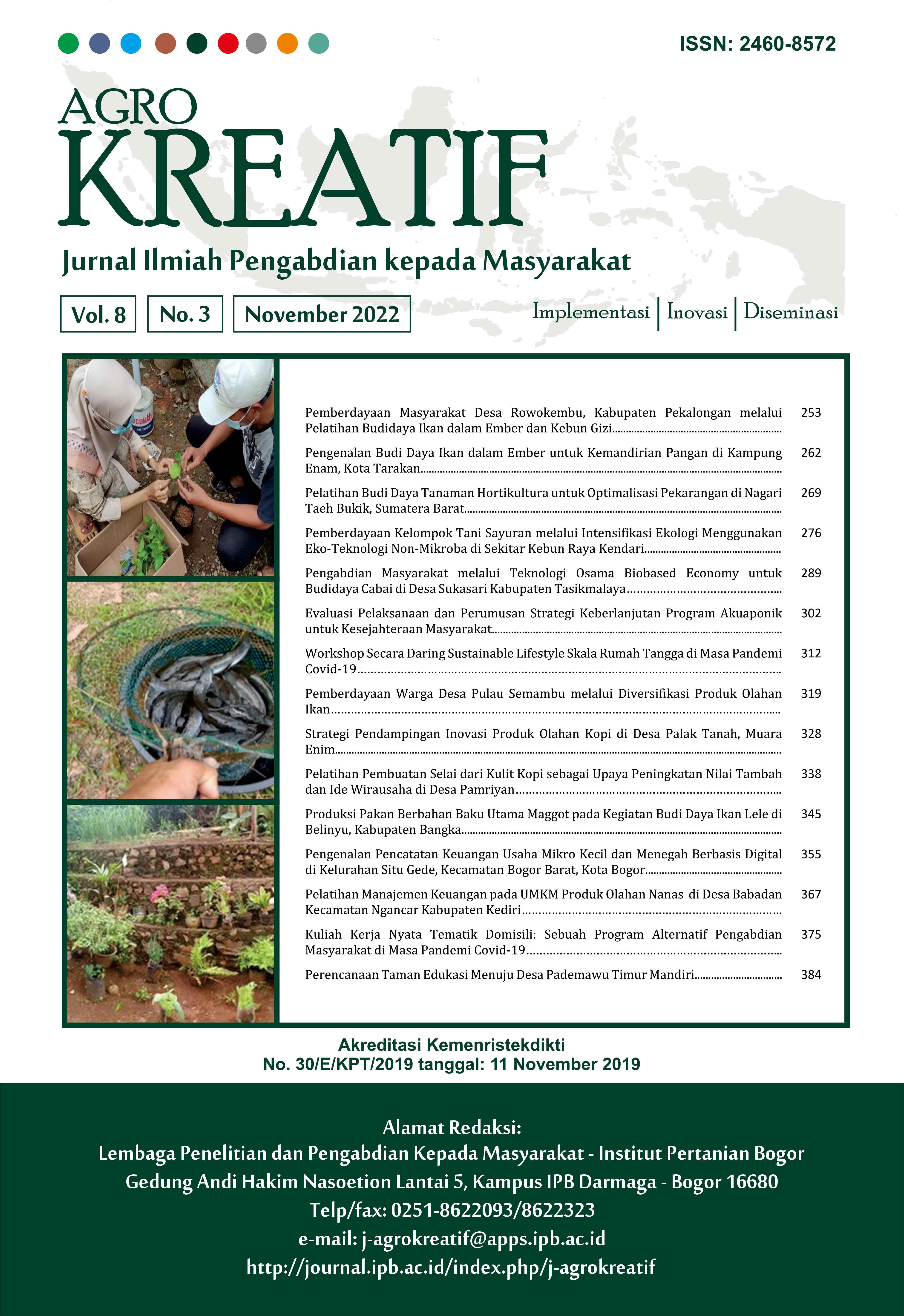Pemberdayaan Kelompok Tani Sayuran melalui Intensifikasi Ekologi Menggunakan Eko-Teknologi Non-Mikroba di Sekitar Kebun Raya Kendari
Abstract
Agricultural Innovation in the green revolution contains high ecological risk, so that eco-technology innovation is needed for the sustainability of agricultural productivity. Unfortunately, not all farmers know about of this innovation, including members of the Nanga-Nanga Makmur Farmers Group around the Kendari City Botanical Gardens. This Community Partnership Program aimed to: (i) increase the knowledge and skills of target farmers regarding the management of abundant organic waste around farmers' fields to be used as non-microbial biofertilizer products; and (ii) provide knowledge to target farmers about conducting soil quality testing as a reference for farmers to determine the dose of non-microbial biofertilizer on managed agricultural land by members of the farmer groups. The method applied to achieve this goal is to do incidental counseling through face-to-face activities, training activities through mentoring in plot demonstration actions. Data on the increasing knowledge and skills of farmers were recorded through photos during mentoring and pilot demonstrations and analyzed descriptively. The results of these activities have increased the knowledge and skills of farmers in evaluating soil fertility using KIT for soil analysis, and determining the need for organic matter and fertilizers. Partner farmers have been able and skilled to produce biochar, compost tea, and compost as non-microbial biofertilizer by utilizing liquid organic waste and organic solid waste. Farmers can to manage soil quality and plant health through the application of non-microbial biofertilizer to soil and plants. Farmers also have insight into pest/disease control through an eco-technology approach.
Downloads
References
Ahmed A, Abu Bakar MS, Sukri RS, Hussain M, Farooq A, Moogi S, Park YK. 2020. Sawdust pyrolysis from the furniture industry in an auger pyrolysis reactor system for biochar and bio-oil production. Energy Conversion and Management. 226: 113502. https://doi.org/10.1016/j.enconman.2020.113502
[BPS] Badan Pusat Statistik. 2020. Kecamatan Kambu Dalam Angka 2020. Badan Pusat Statisitik Kota Kendari.
Bani A, Borruso L, Nicholass KJM, Bardelli T, Polo A, Pioli S, Gómez-Brandón M, Insam H, Dumbrell AJ, Brusetti L. 2019. Site-Specific microbial decomposer communities do not imply faster decomposition: results from a litter transplantation experiment. Microorganisms. 7: 349. https://doi.org/10.3390/microorganisms7090349
Birmingham A, Andreller IS, Kovacks E, Lafontaine JP, Avelino N, Gries GJ, Vaudry AL, Borden JH. 2008. Method and composition for attracting fruit flies to traps. Patent EP 2124536A1.
Cesarz S, Reich PB, Scheu S, Ruess L, Schaefer M, Eisenhauer N. 2015. Nematode functional gulids, not trophic groups, reflect shift in soil food webs and processes in response to interacting gobal change factors. Pedobiologia. 58(1): 23–32. https://doi.org/10.1016/j.pedobi.2015.01.001
Fermin U, Purwanti RE, Kilowasid LMH, Nuraida W, Handayani FD, Mudi L. 2020. Penerapan zero waste di pemukiman warga sekitar tempat pembuangan akhir sampah di Kecamatan Puuwatu, Kendari. Agrokreatif Jurnal Ilmiah Pengabdian Kepada Masyarakat. 6(1): 1–7. https://doi.org/10.29244/agrokreatif.6.1.1-7
González-Hernández AI, Suárez-Fernández MB, Pérez-Sánchez R, Gómez-Sánchez MA, Morales-Corts MR. 2021. Compost tea induces growth and resistance against Rhizoctonia solani and Phytophthora capsici in pepper. Agronomy. 11: 781. https://doi.org/10.3390/agronomy11040781
Haddaway NR, McConville J, Piniewski M. 2018. How is the term ‘ecotechnology’ used in the research literature? A systematic review with thematic synthesis. Ecohydrology & Hydrobiology. 18(3): 247‒261. https://doi.org/10.1016/j.ecohyd.2018.06.008
Hasyim A, Boy A, Hilman Y. 2010. Respons hama lalat buah jantan terhadap beberapa jenis atraktan dan warna perangkap di kebun petani. Jurnal Hortikultura. 20(2): 164‒170.
Kilowasid LMH, Sanjaya MF, Rakian TC, Alam S, Djafar MK, Muliddin. 2020. Vermicast of earthworm as ecosystem engineers within different vermireactor shape. Journal of Tropical Soils. 25(2):83–92. https://doi.org/10.5400/jts.2020.v25i2.83-92
Kim MJ, Shim CK, Kim YK, Hong SJ, Park JH, Han EJ, Kim JH, Kim SH. 2015. Effect of aerated compost tea on the growth promotion of lettuce, soybean, and sweet corn in organic cultivation. The Plant Pathology Journal. 31(3): 259‒268. https://doi.org/10.5423/PPJ.OA.02.2015.0024
López-Mondéjar, R., D Zühlke, D Becher, K Riedel, P Baldrian. 2016. Cellulose and hemicellulose decomposition by forest soil bacteria proceeds by the action of structurally variable enzymatic systems. Scientific Reports. 6: 25279. https://doi.org/10.1038/srep25279
Macura B, Piniewski M, Księźniak M, Osuch P, Haddaway NR, Ek F, Andersson K, Tattari S. 2019. Effectiveness of ecotechnologies in agriculture for the recovery and reuse of carbon and nutrients in the Baltic and boreo-temperate regions: a systematic map. Environmental Evidence. 8: 39. https://doi.org/10.1186/s13750-019-0183-1
Martin CCG St, Dorinvil W, Brathwaite RAI, Ramsubhag A. 2012. Effects and relationships of compost type, aeration and brewing time on compost tea properties, efficacy against Phytium ultimum, phytotoxity and potential as a nutrient amendment for seedling production. Biological Agriculture & Horticulture. 28(3): 185–205. https://doi.org/10.1080/01448765.2012.727667
Muhlizhin R, Sudianto UK, Andryan R, Kilowasid LMH. 2018. Ekstrak Patiwala untuk Mencegah Serangan Nematoda pada Akar Tanaman Tomat Lokal Muna. Laporan Program Kreativitas Mahasiswa (PKM)-Penelitian Eksata, Pekan Ilmiah Mahasiswa Nasional, Universitas Negeri Yogyakarta (tidak dipublikasi), 24 halaman.
Pane C, Celano G, Villecco D, Zaccardelli M. 2012. Control of Botrytis cinerea, Alternaria alternate and Pyrenochaeta lycopersici on tomato whith whey compost-tea applications. Crop Protection. 38: 80–86. https://doi.org/10.1016/j.cropro.2012.03.012
Pingali PL. 2012. Green revolution: impacts, limits, and the path ahead. PNAS. 109 (31): 12302–12308. https://doi.org/10.1073/pnas.0912953109
Samal PK, Lodhi EMS, Arya SC, Sundriyal RC, Dhyani PP. 2016. Eco-technologies for agricultural and rural livelihoods in North East India. Current Science. 111(12): 1929–1935. https://doi.org/10.18520/cs/v111/ i12/1929-1935
Taridala SA, Wianti NI, Arsyad M, Ekaputri AS. 2018. A contrast among farmers’ ethnic groups: isthis a social polarization tendency?E3S Web of Conferences. 52: 00044. https://doi.org/10.1051/e3sconf/20185200044
Tittonell P, Giller KE. 2013. When yield gaps are poverty traps: The paradigm of ecological intensification in African smallholder agriculture. Field Crops Research. 143: 76–90. https://doi.org/10.1016/j.fcr.2012.10.007
This work is licensed under a Creative Commons Attribution-NonCommercial 4.0 International License.



















